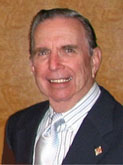Scientific/Engineering:
M.S., Aeronautical Engineering, University of Michigan
B.S., Engineering, U S Military Academy, West Point, NY
Air Force Training-with-Industry, Hughes Aircraft Co.
Management:
Ph.D. (ABD), Business Administration, American University,
MBA, Business Administration, George Washington University
National War College, Fort McNair, D.C.
Industrial College of the Armed Forces, Fort McNair, D.C.
Summary:
Principal and Senior Scientist for Analytics International Corporation with 15 years of broad-based experience in nuclear weapon safety developing, managing, conducting and reviewing life-cycle probabilistic risk assessments (PRAs) of entire nuclear weapon systems. Previous experience included 11 years supporting the Defense Nuclear Agency (DNA) in Europe, by identifying and filling diverse requirements for improving Theater Nuclear Forces (TNF) in Allied Command Europe (ACE) and US European Command (EUCOM). This included: improved survivability of nuclear forces; dispersed basing: and, design of a dispersed command and control system for nuclear forces in Europe, to augment/replace the ACE Status, Control, Alerting and Reporting System (SCARS II).
Earlier experience in the Air Force included: Special Assistant to the Air Force Chief of Staff for B-1 [bomber] Matters; command responsibility for a Minuteman III ICBM wing (150 missiles/450 nuclear warheads) and host for a B-52/KC-135 bomb wing, F-106 interceptor squadron and Army ballistic missile defense unit; preparation and presentation of Air Force R&D budgets to congress; identification of intelligence requirements for weapon delivery guidance systems; and, experimental flight test of air-to-air missile systems (4500 flying hours).
Experience:
2004-present Principal of Analytics International Corp., currently teamed with SAIC on contract HDTRA1-04-D-0031 for Nuclear Deterrence and MWD Support Program.
2000-2004 Consultant to DDTR (DTRA001-00-C-0131) on matters of nuclear weapon safety, probabilistic risk assessments, DOE coordination, technical exchanges with the Russian Federation, and peer reviews. Principal Investigator for Comparison of C-17A/C-141B in the PNAF special mission role, and the so-called “Special Project.”
1990-2000 Manager for technical support to DTRA (DNA001-93-C-0138) and its predecessors on nuclear weapon safety and weapon system safety assessments. Satisfied DTRA requirements for scientific and technical assistance. Developed and implemented DTRA weapon system safety assessment (WSSA) methodology for the W78/W87 Minuteman III. Supervised five scientists/engineers and six scientific/technical consultants. Oversaw three ongoing nuclear WSSAs: B61-7/W80-1/B83-1 B-52H WSSA; B61-3/-4/-10 Dual Capable Aircraft (DCA) in Europe WSSA; and, B61-7/-11/ B83-1 B-2A WSSA. Conducted DTRA WSSA peer reviews. Responded to ad hoc DTRA requirements for specialized studies, e.g., “Special Study of the ‘Trinity’ Issue,” requested by the Office of the Secretary of Defense and “Expected Frequencies of Prime Nuclear Airlift Force (PNAF) Crashes: Air Force and Commercial Crash Frequencies,” and, “A WSSA for a Russian Nuclear Weapons System.”
1979-1990 Deputy Program Manager for RDA-Europe: a field office supporting the Defense Nuclear Agency in Europe by identifying and satisfying Allied Command Europe (ACE) and U.S. European Command (EUCOM) requirements to improve Theater Nuclear Forces. Worked with NATO, Supreme Headquarters Allied Command Europe (SHAPE), EUCOM, and subordinate commands from Norway to Turkey. Areas of interest included nuclear operations planning; nuclear weapon release procedures; targeting for nuclear weapons; survivable command, communications and nuclear forces; forward basing; and, weapon storage.
Selected Publications:
Review: DDESB Technical Paper No.14, “Risk-Based Explosives Safety.” DTRA-IR-02-xx, Defense Threat Reduction Agency, Alexandria, VA. October 2002. (Principal author, with Richard W. Mensing and Douglas R. Stephens.)
“Treatment of Uncertainty in the Estimation of Risk,” DoD Explosives Safety Board Seminar, Atlanta, GA, August 2002. (Co-author with Richard W. Mensing.)
Risk Comparison: C-141B and C-17A Aircraft in the PNAF Role, DTRA-IR-01-31 Defense Threat Reduction Agency, Alexandria, VA. June 2001. (With Everett Saverino.)
“Electric Field Strength Limits: Vee Curves and Step Curves,” draft, March 2000. (Co-author with William S. Kehrer.)
Special Study of the “Trinity” Issue, DTRA-TR-99-20, Defense Threat Reduction Agency, May 1999.
“Probabilistic Modeling of Safety Risks of Aircraft Crashes into Structures,” Probabilistic Safety Assessment, Volume II, The Amer. Nuclear Society, Park City, UT, September 29 – October 3, 1996. (Co-author with Dr. Richard W. Mensing.)
“Risks of Aircraft Crashing into Facilities Containing Hazardous Materials: Integrated Aircraft Crash and Structural Response Model,” Proceedings of the 14th International System Safety Conference, System Safety Society, Albuquerque, NM, August 12-17, 1996. (Co-author with Dr. Richard W. Mensing.)
“Minuteman III Weapon System Safety Assessment (WSSA),” Proceedings of the 14th International System Safety Conference, System Safety Society, Albuquerque, NM, August 12-17, 1996.
Proceedings of the Aircraft Crash Dynamics and Structural Response Workshop, Editor, Logicon RDA, Albuquerque, NM, 1-2 March 1995.
W78/W87 Minuteman III Weapon System Safety Assessment, Defense Nuclear Agency, Alexandria, VA, February 1994. CLASSIFIED. (Principal author.)
“External Events in Risk Assessments: Lightning Attachment and Aircraft Crashes into Structures,” Safety Engineering and Risk Analysis 1994, Amer. Soc. of Mechanical Engineers (ASME), 1994 International Mechanical Engineering Congress and Exposition, Chicago, IL, November 6-11, 1994.
Joint DoD/DOE Study of the Logistic Movement of Nuclear Weapons, Defense Nuclear Agency, Alexandria, VA, 1991. (With others, including DOE.)
